Verbal reasoning tests are among the most common aptitude assessments for recruitment besides numerical reasoning tests and logical reasoning tests. Their purpose is to enhance the hiring quality and help employers find the best within their talent pool based on comparative test data. Candidates who pass these tests and go to the subsequent interviews seem to be more competitive, intellectual, adaptable, and fit for the positions they have applied for.
Therefore, you need to be well-prepared for verbal reasoning tests before applying for a position. The better result of the test you get, the more likely you’re invited to the interview, the higher chance you can win the job.
In this article, we’ll give you a comprehensive knowledge of verbal reasoning tests, including their definition, question types, common test providers, and a series of practice tests.
Table of Contents
What is a verbal reasoning test?
Verbal reasoning tests assess the ability to understand written information and analyze logical relationships between words to make accurate conclusions. There are five types of verbal reasoning questions: synonym & antonym, word analogy, word association, reading comprehension and making inferences. Most of them are in the form of multiple-choice questions. To pass reasoning reasoning tests, candidates are required to have a good vocabulary from B1 to C2 level, master skimming & scanning and make logical inferences.
These tests are typically used in the screening round of a recruiting process, which helps employers decrease the number of candidates by filtering out those with poorer cognitive skills.
A verbal reasoning test typically includes 5 types of questions:
- Synonyms & antonyms
- Analogy
- Word association
- Reading comprehension
- Verbal reasoning (make simple inferences)
The majority of verbal reasoning tests cover reading comprehension and verbal reasoning (making simple inferences). Look at the following table to know exactly what type of question in each test provider’s verbal reasoning tests.
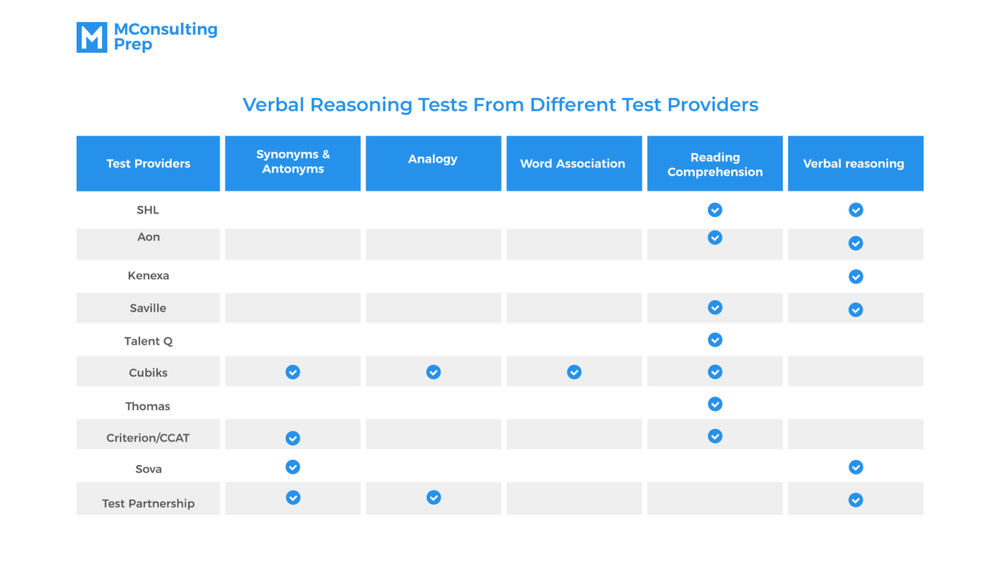
And to correctly answer these question types, test takers should get well prepared as follows
- Enrich vocabulary
- Improve skimming & scanning skills
- Read between the lines
We will dig deeper into those parts later in this article. So keep moving!
How long is a verbal reasoning test?
Verbal reasoning tests usually involve a text of 150-250 words with 15-20 questions and do not last longer than 15-20 minutes. Thereby, as a rule of thumb, you should spend about 1 minute on one question. These tests are designed so that only 1-2% of test takers can accurately answer all the questions within the time limit.
What is a “passing” score for verbal reasoning tests?
Your percentile rank should be at least 75. It means your score should be higher than 75% of other test takers at the same level.
Actually, there is no “pass” score for verbal reasoning tests. Rather, your score is compared to a benchmark based on others’ scores at a similar level and in a similar job to the one you’re applying for. This allows employers to have a more accurate assessment of your verbal reasoning skills.
Well, your result is calculated compared to that of other people in similar roles. Unfortunately, this means even if you precisely answer most of the questions in the test, your result may still be lower than the average in the occupation you are applying for.
For example, you precisely answered 27 of 30 questions in the test, and you feel this is a “good result”. However, other people in that test correctly answer 28 of 30 questions on average. Then, your “good result” turns out to be not good because it’s lower than the average result of other test takers who do the same test as you.
Why are verbal reasoning tests used in recruiting?
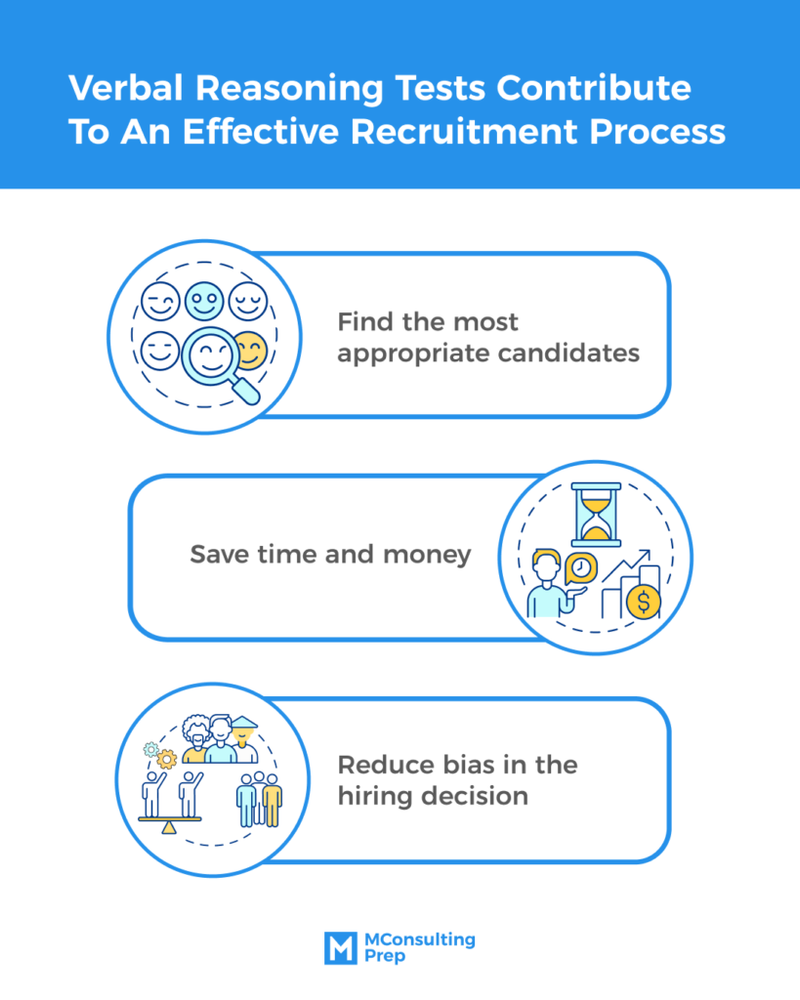
As mentioned before, verbal reasoning tests are often used by employers to test potential employees’ skills in the initial stages of the application process. Employers focus on assessing how you think instead of what you know. Your verbal reasoning score along with interview performance will help recruiters find the most suitable candidates for the role.
Specifically, there are three major reasons why verbal reasoning tests become so important.
- Find the most appropriate candidates
- Save time and money
- Reduce bias in the hiring decision
Verbal reasoning tests find the best candidates
Organizations that use pre-hire assessments (including verbal reasoning tests) are 24% more inclined to have candidates who surpass performance goals. Besides, the tests vary based on the required skills or behaviors of the position, such as coding or software competency, and soft skills like personality or traits. Hence, recruiters can choose the most suitable verbal reasoning tests that match their requirements for potential employees.
Verbal reasoning tests save costs and time
Using verbal reasoning tests as pre-assessment can save a considerable amount of time and money. Sifting through hundreds of applications is a time-consuming, draining, and complicated task. This aptitude test will help zero in on the most excellent candidates in a huge talent pool. Simply with a 15-20 minutes test, employers can find out which applicants are ready for the interviewing round.
Verbal reasoning tests mitigate bias
Verbal reasoning tests add an objective perspective to the hiring process, which helps reduce bias significantly.
Even the most equal-chance employers may have unconscious biases about abilities that may make them treat applicants unequally. For instance, an employer may unintentionally prefer male applicants for technical positions or female applicants for people-person positions due to societal stereotypes.
Five question types of a verbal reasoning test
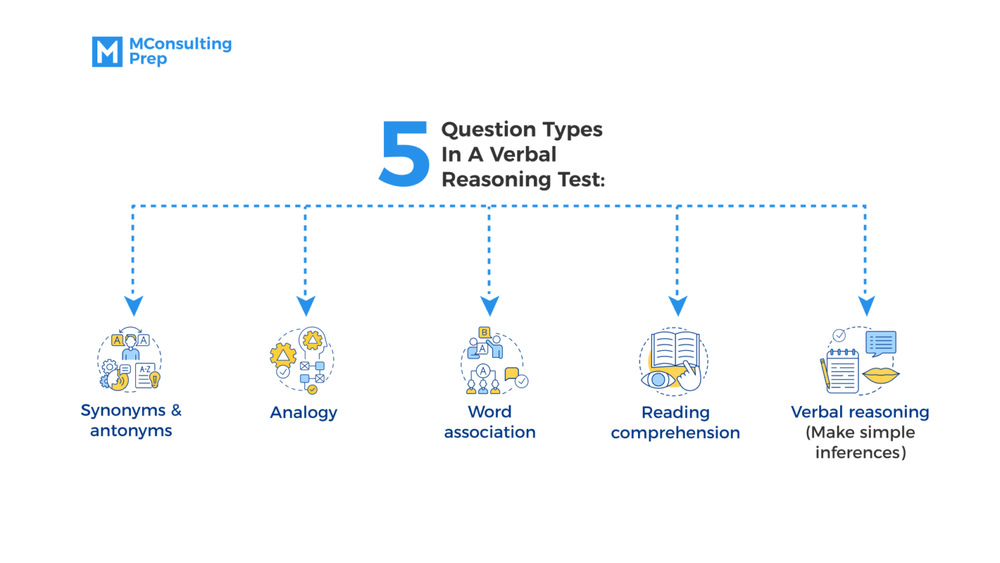
Verbal reasoning tests have numerous versions based on various purposes and providers. However, there are 5 popular question types in verbal reasoning tests, including:
- Synonyms & antonyms
- Analogy
- Word association
- Reading comprehension
- Verbal reasoning (Make simple inferences)
Note
Analogy, Reading comprehension, and Making inferences are the three most common question types you’ll encounter in the actual verbal tests. Get yourself familiar with these questions by practicing our verbal reasoning package. To make things even better, we also have free practice tests you can take to see how you're doing.
Synonyms & antonyms
Synonyms & antonyms question is a widely-seen type in verbal reasoning tests. This question asks you to spot a synonym/ antonym out of a list of four or five words.
Look at these five adjectives: befuddled, perplexed, exhilarated, flummoxed, baffled. The four words (befuddled, perplexed, flummoxed, baffled) have similar meanings (synonyms) and the rest – exhilarated – is a word with the opposite meaning (an antonym).
Note
This type of question is common in gamified tests from Criteria and Test Partnership.
- Criteria Corp produces a verbal mini-game that sets 90 seconds for you to practice a range of synonym and antonym questions. The question gives two words – users need to decide whether these two words are “opposite” to each other or the “same”.
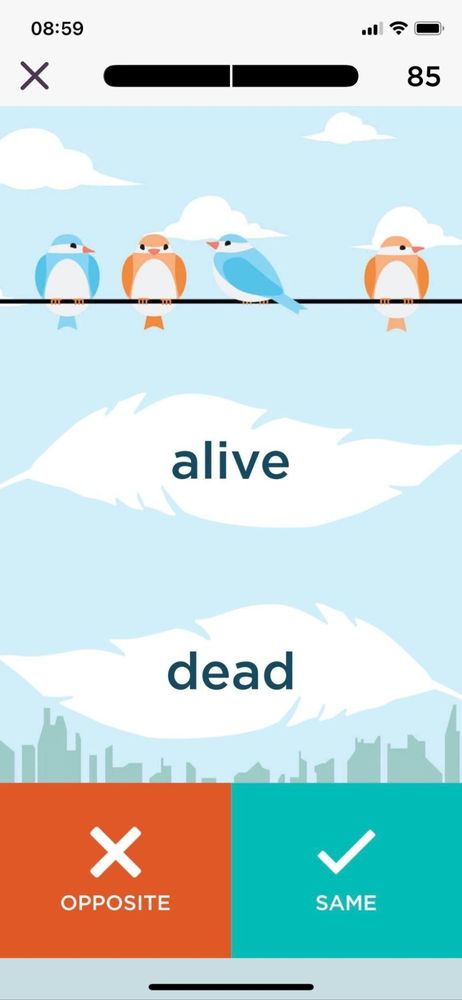
- In MindmetriQ Gamified Assessments of TestPartnership, there is a game called “Link Swipe” for you to practice synonym/antonym questions. Users are given a couple of words and must swipe to show whether that couple of words is approximate antonyms, synonyms, or neither. This game typically takes 4 minutes to complete.
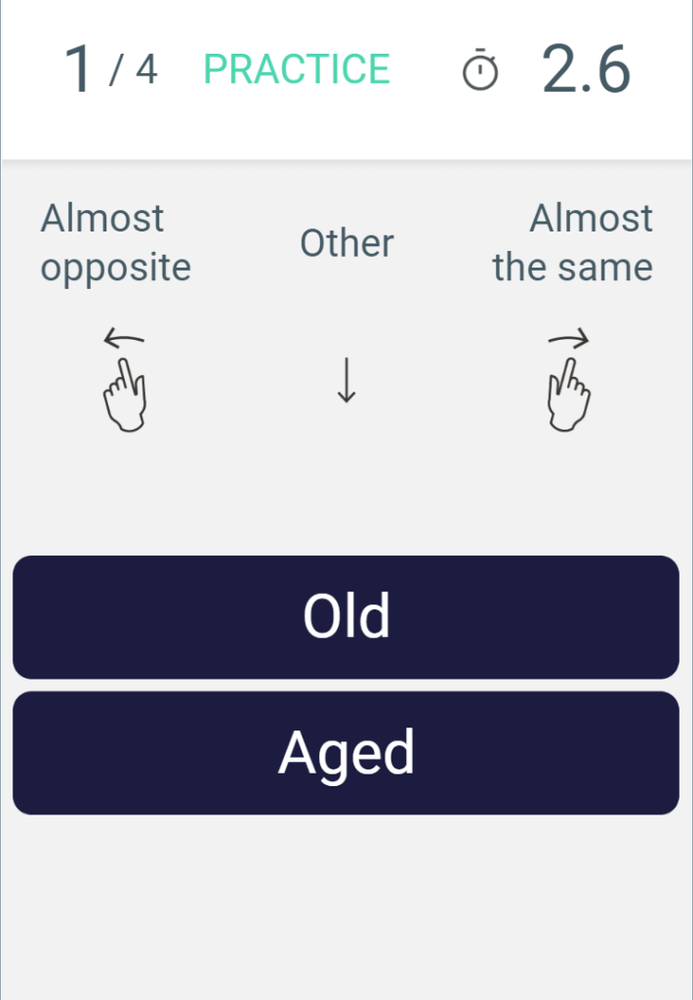
Source: TestPartnership
Analogy
Analogy questions test the ability to identify relationships between pairs or sets of words or ideas. The questions can contain many different word and concept links, but the question structure is similar.
In general, analogy questions will contain two parts. The first part includes an example pairing that presents a specific relationship. The second part contains a word – you need to find its corresponding one within multiple-choice answers based on the relationship of the example.
These questions usually contain 7 bridges of word connections. Let’s explore them in detail and with examples.
- Synonym/Antonym
- Item to category
- Cause & effect
- Characteristics
- Function
- Degree
- Group
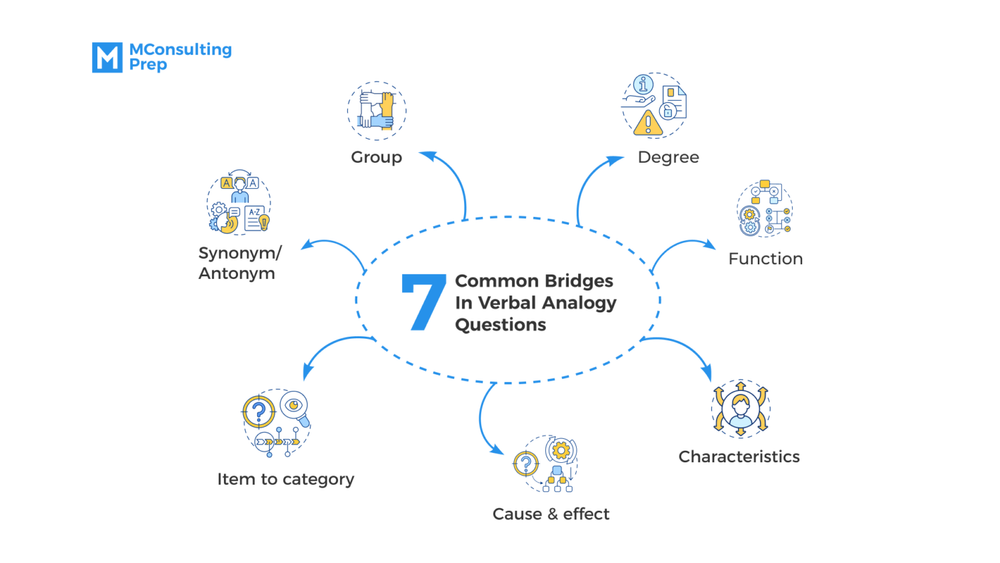
As answering the questions, remember that the linking logic may need to be entailed in the reverse order to match the unattached word to its partner word.
From the given example, “democracy” can be pointed as a cause, and “liberty” as a potential effect. “Disciplinarian” is an effect, so the right answer will be a cause. The correct answer is option C, “severity”.
“Crawling” is the movement of a “caterpillar”, just as “soaring” is the movement of an “eagle”. The right answer is A.
All the options are related to the lone word “dice”. Options A and C are related to the lone word in terms of knife skills. Option D “blade” relates to the context but is at a different level from the relationship identified.
Dicing can occur on a blade. In the given example, you use a “scissor” to “cut, so you would use option B, a “knife” to “dice”.
In analogy questions, multiple-choice options often relate to the words in the question. That will cause confusion, so read through all the answers carefully.
For this one, you might choose option C “happy” as it’s a synonym for “cheerful”. However, in the example pair, “extreme” is not just a straight synonym for “great” – the degree of the adjectives increases significantly.
Applying the logic to the unresolved pair and the correct answer is option D, “satisfied”.
From the example pairing, a “pack” is a group of “wolves”. Similarly, a “gaggle” is a group of “geese”. The correct answer is option B.
Word association
Word association means a relation between a word and other words based on a semantic relationship. Word association questions require you to pick the odd one out of the rest. Here are some examples of word associations:
- Food: noodles, meat, beef, pizza, vegetables, fish, seafood, etc.
- Drinks: lemonade, alcohol, cocktail, juice, water, soda, etc.
- Countries: USA, UK, French, China, Japan, Vietnam, Korea, etc.
- Sports: Badminton, soccer, swimming, baseball, basketball, etc.
- Nouns: Significance, determination, decision, bravery, etc.
- Smells: Sweet, fragrant, citrus, fruity, chemical, etc.
This is the rarest type of question in verbal reasoning tests available on the market. Cubiks is the only test provider that includes word association questions in its verbal reasoning tests.

Source: Cubiks
Answer: Letter
Explanation: “Coin”, “Banknote”, “Cheque” and “Credit Card” are all related to money. Therefore, “Letter” is the odd one out.
Reading comprehension
Reading comprehension questions assess your ability to read a passage of information quickly, and spot relevant details from the passage. Time limits vary among tests. Some verbal reasoning tests have a time limit for the whole test, while some set a time limit for each question.
These reading comprehension questions are in a multiple-choice format. They may require test takers to scan through a passage of information, then determine which statement is correct/ incorrect based on the above passage.
Note
Reading comprehension questions have 2 different levels of difficulty based on test providers: Simple and Advanced
| Simple Reading Comprehension | Advanced Reading Comprehension | |
|---|---|---|
| Length of text | 100-150 words | 200-250 words |
| Number of options | 4 options | 6 options |
| Language level | B2-C2 | C1-C2 |
| Difficulty level | Test takers easily find the right answers based on the information in the statements. | Test takers need to scan through the passage to find out which option(s) is/are the best answer(s) for the statement. |
| Difficulty level | There is only ONE correct option. | There may be 1-2 correct options. |
| Test providers | SHL, Aon, Hudson, Saville, Thomas, Criteria | TalentQ |
Take a look at these two examples:
Simple Reading Comprehension Questions
In passive voice sentence construction, the form of the auxiliary verb, “to be”, usually precedes the verb then followed by a preposition, usually “by”. These words add clutter and take away the directness of an action. Without a direct web, a sentence is often listless. Passive voice can also make a sentence awkward by reversing the “who did what to whom” relationship. Subject-verb-object is the dearest and most concise sentence construction. Use of passive voice formality may come from academic writing and reading. It is the favorite construction for politicians and scientists. The passive voice can be useful when the recipient is more important than the subject or the subject is unknown. (112 words) – Source: SHL
Which sentence structure is the clearest, most concise sentence construction
A. Subject-verb-object
B. Verb-object-subject
C. Recipient-subject-verb
D. Recipient-verb-subject
Advanced Reading Comprehension Questions
Milk Industry
Farming advocacy groups believe that the government must step in to prevent further milk price cuts. Dairy farmers claim that milk prices are currently lower than the cost of production. Gareth Evans, a representative from Dairy Association, says, “Further cuts will drive one in ten hard-working dairy farmers out of business and result in shortages necessitating milk importation.”
Whereas in most industries, manufacturers set the price of their product, milk prices are dictated by the large milk processors that supply the supermarkets. Supermarkets today earn a 35% margin on milk, as compared to 10% in 1995. While milk processors blame falling commodity prices, farming unions attribute low milk prices to the processors’ fight for market share. The government cannot set milk prices, but agriculture ministers have urged the adoption of a voluntary pricing code between farmers and processors to ensure fair pricing.
Not everyone agrees that farmers deserve special protection. Some critics believe that farming subsidies enable farmers to run unproductive, unprofitable businesses – a luxury unheard of in other industries. As only 13% of the UK’s milk comes from farms producing less than 500,000 litres of milk per annum, removing state protection and allowing these small farms to fail is unlikely to significantly impact the nation’s milk supply. (211 words) – Source: TalentQ
Which two of the following is Gareth Evans protesting against?
A. Milk importation
B. Poor promotion of dairy farming businesses
C. Recent cuts in the price of milk
D. Protecting dairy farmers
E. Supermarkets’ monopoly of the milk market
F. Future reductions in milk prices
Verbal reasoning (make simple inferences)
Verbal reasoning questions require you to make simple inferences based on the statements given in the text. They closely imitate specific ideas in the text, and it’s your task to decide on the most suitable conclusion.
These questions are in the form of a written passage along with a range of questions with possible True, False, or Cannot Say responses. If you want to get a high score, you need to appreciate the meaning of each response.
- True – The statement logically follows the information in the passage.
- False – The statement CANNOT logically follow the information in the passage.
- Cannot Say – It’s impossible to decide whether the statement is true or false based on the information in the passage.
Below’s an example of a verbal reasoning question:
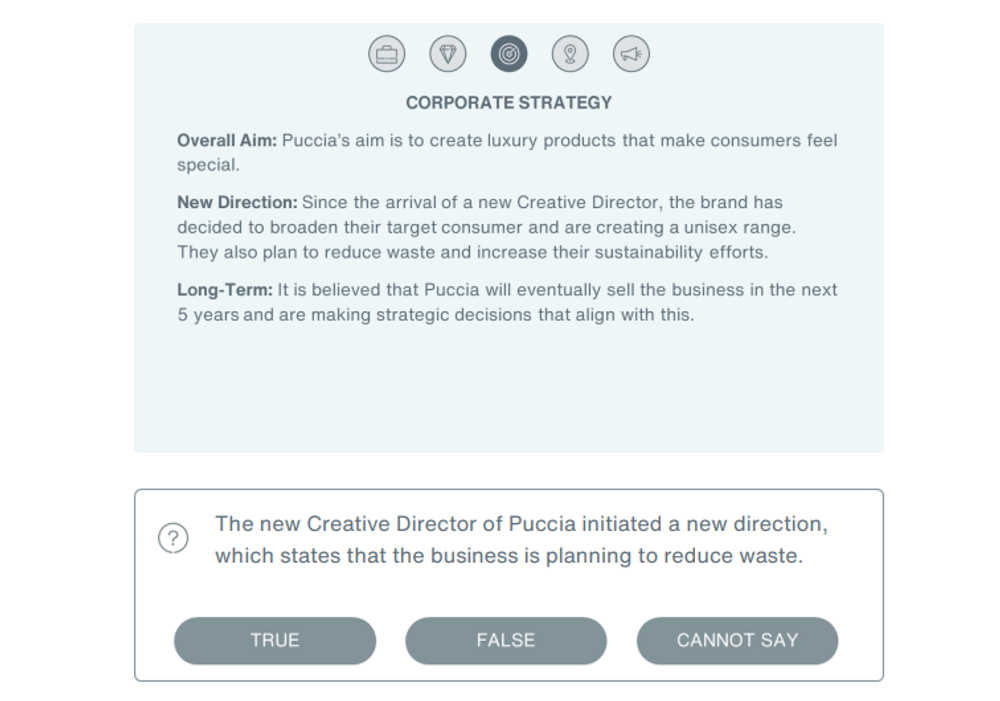
Source: Aon (Cut-e)
Statement: The new Creative Director of Puccia initiated a new direction, which states that the business is planning to reduce waste.
Answer: Cannot say
Explanation: We cannot 100% confirm whether the business’s direction to reduce waste was created by the new Creative Director. The passage only mentions that they started the new direction since the Creative Direct came. However, there is NO direct connection between waste reduction and the new direction, and it DIDN’T mention who was responsible for the idea of reducing waste.
Popular verbal reasoning test providers
SHL
SHL is among the most dominant pre-employment test providers. Its verbal reasoning test is a graduate-level and above assessment that evaluates your ability to understand written information and assess argument about it. The information is presented in the form of short passages, accompanied by statements with three possible answers – True, False, or Cannot Say.
The SHL verbal reasoning tests include 30 questions to be resolved in 19 questions – you’ll have about 40 seconds for one question.
You can access a full-length SHL verbal reasoning practice test here.
Talent Q
Talent Q or Korn Ferry is well known for providing aptitude assessment solutions. Talent Q Elements Verbal Test evaluates your ability to comprehend written material.
This test contains 15 questions and offers you 75 seconds time limit to answer the first question and 60 seconds for each subsequent question. Every question on the test has a text passage followed by a multiple-choice question. The unique point of the test is being adaptive, which means the difficulty level rises whenever you get a correct answer and decreases as you answer incorrectly.
You can access a Talent Q verbal reasoning practice test here.
Saville
Saville Assessment is an international business management consultancy and talent acquisition firm. The company has earned a reputation for its verbal reasoning tests, which are widely used by employers all over the world and in various industries.
Saville provides two types of verbal reasoning tests:
- 24-minute verbal analysis aptitude test. It’s often used for professional, management, and graduate ones. Candidates will get paragraphs of text, and are required to choose true, false, or cannot say on a set of statements based on the written prompt.
- 16-minute verbal comprehension aptitude test. It’s used for entry-level roles, and mixes questions as above with word-definition problems.
Talogy
Having had a 70-year story, Talogy (Cubiks) was created in 1946 with the aim to use assessments to help young adults join the workforce after a period of work turmoil. That purpose has been preserved and developed, which helps solve talent challenges for companies all over the world.
With Talogy verbal reasoning tests, candidates need to answer 36 questions in 15 minutes. There are a lot of simulations and additional exercises from this test provider that can help improve your test outcome within a few days of intensive practice.
You can practice a Cubiks verbal reasoning test here.
Aon (Cut-e)
Aon’s aptitude tests are often used by several major companies looking for talented employees. These tests are considerably challenging, with the use of unfamiliar formatting and scoring methods, which requires expert technique to get a high score.
Verbal reasoning tests in Aon are called Scales Verbal tests. They measure your ability to understand texts and interpret the information included. You must define whether a statement is true, false, or undefinable by selecting the correct tab and finding the relevant answer. There are 49 questions to be answered in 12 minutes – you have 15 seconds for one question.
Here is the practice test for Aon verbal reasoning tests.
Kenexa
Kenexa, a child company of IBM, offers employment and retention services. This covers recruitment process outsourcing onboarding tools, employee assessment, abilities assessment for potential candidates, and Kenexa Interview Builder.
Kenexa verbal reasoning tests come in different forms and are often designed for the type of job you apply for. For instance, if you are applying for a consulting position, you will be given a passage that relates to that job role. Thus, these questions are not only a measuring tool for your verbal reasoning skills but also can access your consulting skills.
How to pass verbal reasoning tests?

There are a few things you need to prepare so that you can pass verbal reasoning tests smoothly, including:
- Enrich vocabulary
- Improve skimming & scanning skills
- Read between the lines
Enrich vocabulary
Expanding your vocabulary is considered your first preparation for verbal reasoning tests as they require the comprehension of concepts delivered in words within the use of reasoning. Your English level should be from B1 to C1, even C2 so that you can handle a wide range of texts in these tests.
- 80% of the text covers general topics (environment, space, psychology, education, medicine, etc.);
- 15% of the text relates to business topics (business, finance, etc.);
- 5% of the text is about specialized knowledge of a specific field (the detailed operation of an aeroplane, how the blood circulatory system works, etc.)
Moreover, typical verbal reasoning tests contain questions related to grammar, spelling, analogies, word swaps, finding new words, comprehension, and sentence completion. Therefore, no matter whether you’re a native English speaker or have English as a second language, you’re better off spending much more time enlarging your vocabulary. Our verbal reasoning mock tests include a large amount of paraphrasing ranging from easy and difficult levels, which helps you expand your vocabulary significantly.
There are a lot of ways to enrich your vocabulary effectively. For example:
Read more and more
To solve verbal reasoning tests, you can read popular English newspapers, including The Independent, The Times, The Economist, The Guardian, The Financial Times, Fortune, and Time magazine. While reading an article, analyze the key arguments mentioned and discover how the author backs these arguments.
Use dictionaries and thesaurus
These helpful sources can educate you about root words, different meanings of words, synonyms and antonym, detailed examples, etc so that you can have a deeper understanding of the words. Widely-used dictionaries include Oxford Learner’s Dictionaries, Cambridge Dictionary, Merriam Webster Dictionary, Longman Dictionary, Collins Dictionary, Thesaurus, Cambridge Thesaurus, etc.
Use free English vocabulary learning sources
There is a variety of English vocabulary learning apps and websites that allow you to learn and practice anytime as long as you’re connected to the Internet. For example: Quizlet.com and app, memrise.com, learnenglish.britishcouncil.org, Word of The Day app, etc.
Improve skimming & scanning skills
As verbal reasoning tests are strictly timed, you need to skim and scan passages quickly and properly to get the right answers.
Skimming and scanning are basic reading techniques that involve rapid eye movements and keywords to move quickly through text for slightly different purposes. Skimming shows you what general information is within a section, while scanning lets you locate a particular fact. The majority of questions in verbal reasoning tests require excellent scanning skills.
Take a look at this example to see how skimming and scanning work.

Source: Saville
This type of question requires you to read the statement through. You’ll need to use your skimming and scanning skills to read the passage. Next, you determine whether the statement is true, false, or not given.
First, read the statement carefully and scan its keywords. Then go back to the passage and skim the text to find the sentence containing these words.
In this case, you can see that the statement’s keywords are: eating ‘on-the-go’ and increasingly common. Then go back to the text and scan for these words.
In the second sentence: “The prevalence of eating on-the-go, both snacks and meals, is increasing significantly.
You can see that “increasing significantly” = “increasingly common”. That’s why you’ll know the answer is True on the basis of the passage.
Read between the lines
In verbal reasoning tests, candidates need to read between the lines to find meanings that are intended but are not directly imparted in words. The tests contain some questions requiring you to draw inferences based on the given statements. Bear in mind that you must base your conclusions merely on the provided information in the text. Do not apply your own knowledge or other information to the text.
Here is an example of inferences in verbal reasoning tests:
For years, scientists argued about the theory of continental drift – the idea that the continents were located in multiple locations in the past and even were once integrated into one big continent called Pangaea.
It can be inferred that continental drift theory was created according to the assumption that Earth’s crust is separated into different plates that move around and change over time.
Helpful tips to pass verbal reasoning tests
Discover who your test provider will be
When you find out you are going to take a verbal reasoning test, ask to see a sample of the questions because each verbal reasoning test has a different level. These tests are created by multiple test providers such as SHL, Kenexa, Cubiks, Saville, and Talent Q. Knowing which test provider is, you can practice on the right type of test. That will be a significant advantage as it comes to the real thing.
Make no assumptions
A rule of thumb when taking verbal reasoning tests is NOT to use general knowledge or real-life experience to prove or disapprove a statement. You MUST base on the information given in the text and draw logical conclusions from it.
Verbal reasoning tests may not agree with your prior knowledge. For example, if you know the capital of Japan is Tokyo and the passage asks for its location but doesn’t mention the passage, you SHOULD NOT assume that the passage expects you to know its location. Instead, you should find that out based on the passage, and if it doesn’t tell you, the answer may be Cannot Say, rather than True.
Read the questions before the passage
As mentioned before, passages in verbal reasoning tests may vary from 100-250 words. If you read through the text before the questions, you might run out of time. Since the tests are strictly timed, you should read the questions BEFORE scanning the passage. That way helps you determine which piece of information to look for, so you can find accurate answers faster.
Spend a minute on one question
In addition to the tests which set a time limit for each question, there are some tests that have a time limit for the passage. In those cases, spend ONE MINUTE ON ONE QUESTION. If you’re really stuck on a question, do not waste time figuring it out. During the five minutes you ponder one hard question, you could accurately answer five others.

Practice as much as possible
Practice makes perfect. Taking verbal reasoning practice tests will help you figure out where you might have difficulties in the real test. This might be a timing problem: if you spend too much time on one piece of text to find correct answers, you might run out of time to finish other questions.
Hone your English skills
Whether English is your mother tongue or second language, getting familiar with “business speak” and complex terminology will help you easily pick apart the used language and find the correct answers.
The texts in verbal reasoning tests are often complicated, including formal grammar, technical language, and paraphrases. If you don’t excel in English, you won’t comprehend the passage, thereby missing the most important details.
There are many other types of aptitude tests in addition to verbal reasoning tests. Make yourself well-prepared with a brief overview of aptitude tests.
/filters:quality(75)//case_thumb/public/1699589977462_aptitude_tests_package_4_x.png)